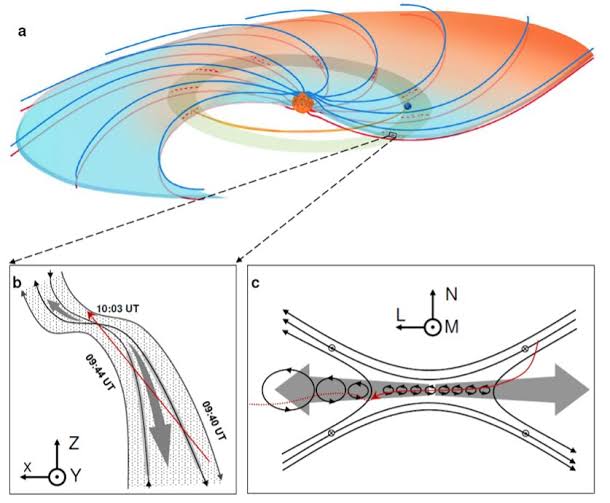Under the guidance of Professors Wang Rongsheng and Lu Quanming, scientists from the University of Science and Technology of China (USTC) of the Chinese Academy of Sciences used data from the Magnetospheric Multiscale (MMS) mission to directly observe bursty and turbulent magnetic reconnection in the solar wind. Their research was made public in Nature Astronomy.
What Are These Magnetic Reconnections?

Explosive occurrences in interplanetary space are brought on by the energy-releasing phenomenon known as magnetic reconnection. The magnetic energy is rapidly released during the procedure to heat and accelerate the plasmas.
Reconnection has previously been observed by satellites, and these observations frequently show a bursty and turbulent state, such as flares on the sun’s surface, geomagnetic storms, and substorms in the planetary magnetospheres.
The Solar Winds
The solar wind, which emanates from the sun and spreads throughout interplanetary space, acts as a transitional mechanism between solar bursts and magnetospheric turbulence.

There haven’t been many direct observations of magnetic reconnection in the solar wind, despite the old perspective suggesting it exhibits a quasi-steady state in contrast to burst and transient forms in planetary magnetospheres.
The study team located the turbulent reconnection in the solar wind using the MMS high-resolution data.
The MMS, a four-spacecraft tetrahedron structure that was launched in 2015, aims to unravel the mysteries of the electron diffusion region of the magnetic reconnection. Since October 2017, the MMS apogee has been increased to 25 Earth radii, allowing data collection in the interplanetary solar wind.
Proofs Of The Turbulent Reconnection In The Solar Wind
The research team discovered direct proof of the turbulent reconnection in the solar wind for the first time. Additionally, the diffusion region’s internal filamentary currents and flux ropes are shown, creating a turbulent diffusion region. The ions and electrons are in fact heated during the turbulent reconnection.
Conclusion
The researchers established that bursty reconnection in the solar wind—which causes solar wind acceleration and heating—is more often than previously believed based on the 76 magnetic reconnection events detected by the MMS. They also discovered that as the solar wind’s speed increases, the frequency of reconnection rises.
This research shows that the energization of plasmas in the solar wind can be greatly aided by turbulent magnetic reconnection.
